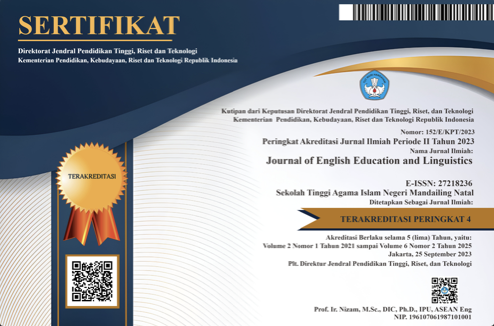TEACHING MORAL VALUES THROUGH EYL LITERATURE: HOW?
DOI:
https://doi.org/10.56874/jeel.v3i1.791Abstract
Abstract: Nowadays, teaching moral values is an obligation for every teacher in Indonesia. One of the ways to promote the moral values to young learners is through literature. As one of the literacy skills, reading skill must be prioritized as early as possible. English teacher as the agent of change can teach the moral values at the same time with teaching English, especially in teaching reading. Applying appropriate strategies and using relevant EYL literatures are assumed as the most effective methods to teach English and core moral values in the classroom. This paper will highlight theoretically the concept of moral value, the concept of good character, and the various strategies and activities to promote the core moral values through EYL literature.
Keywords: character education, literature, moral values, teaching, TEYL
References
Adriyanti, K.Y. (2021). The implementation of character education in teaching English for young learners. The Art of Teaching as a Foreign Language. 1(2), 18-23.
Auciello, J. (2006). Teaching for character: Education for English teachers. Journal of Education, 187(3), 57-69.
Badan Pengembangan dan Pembinaan Bahasa. (2008). Kamus besar bahasa Indonesia. Retrieved from http://kbbi.web.id/
Bohlin, K. E. (2005). Teaching character education through literature: Awakening the moral imagination in secondary classrooms. London: Routledge Falmer.
Cambridge Dictionary. (2008). Cambridge advanced learner's dictionary. Retrieved from http://dictionary.cambridge.org
Ginanjar, A. (2006). Rahasia sukses membangun kecerdasan emosi dan spiritual ESQ: Emotional spiritual quotient berdasarkan 6 Rukun Iman dan 5 Rukun Islam. Jakarta: Arga Wijaya Persada.
Grabe, W. (2009). Reading in a second language: Moving theory to practice. New York, NY: Cambridge University Press.
Hornby. (2010). Oxford Advanced Learner’s Dictionary. Retrieved from http://oald8.oxfordlearnersdictionaries.com
Kabir, A. I. A. (2008). Approaches used by Islamic education teachers to integrate moral values in their teaching: A case study at Ansarul Islam secondary school, Ilorin, Kwara State, Nigeria (Unpublished Dissertation, Institute of Education International Islamic University, Malaysia). Retrieved from http://lib.iium.edu.my/
Kemenkokesra. (2010). Kebijakan Nasional Pembangunan Karakter Bangsa 2010-2025. Retrieved from www.gurupembaharu.com
Krashen, S. D. (2004). The power of reading: Insights from the research. Porstmouth, NH: Greenwood Publishing Group, Inc.
Lickona, T. (2008). Educating for character. New York, NY: Bantam Books.
Lickona, T., & Davidson, M. (2005). Smart & good high schools: Integrating excellence and ethics for success in school, work and beyond. Retrieved from
http://www2.cortland.edu/centers/character/high-schools/SnGReport.pdf
Prestwich, D. L. (2004). Character education in America's schools. School Community Journal,14(1), 139-150.
Rich, D. (2008). MegaSkills®: Building our children’s character and achievement for school and life. Naperville, IL: Sourcebooks, Inc.
Smith, C.B. (2002). Developing character through literature: A teacher resource book. Bloomington, IN: The Family Learning Association, Indiana University. Retrieved from the ERIC database.(ED 464 362)
The Expert Panel. (2003). Early reading strategy. Retrieved from http://www.edu.gov.on.ca/eng/document/reports/reading/reading.pdf
Undang-Undang Dasar RI Tahun 1945 Amandemen ke Empat, Jakarta: 2002
Downloads
Published
Issue
Section
License
All articles published in the Journal of English Education and Linguistics are licensed under a Creative Commons Attribution-ShareAlike 4.0 International (CC BY-SA) license. This means anyone is free to copy, transform, or redistribute articles for any lawful purpose in any medium, provided they give appropriate attribution to the original author(s) and Journal of English Education and Linguistics, link to the license, indicate if changes were made, and redistribute any derivative work under the same license.
Copyright on articles is retained by the respective author(s) without restrictions. A non-exclusive license is granted to the Journal of English Education and Linguistics to publish the article and identify itself as its original publisher, along with the commercial right to include the article in a hardcopy issue for sale to libraries and individuals.
Although the conditions of the Creative Commons Attribution-ShareAlike 4.0 International (CC BY-SA) license do not apply to authors (as the copyright holder of your article, you have no restrictions on your rights), by submitting to the Journal of English Education and Linguistics, authors recognize the rights of readers and must grant any third party the right to use their articles to the extent provided by the license.

This work is licensed under a Creative Commons Attribution-ShareAlike 4.0 International License.








